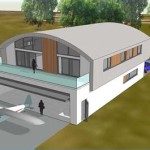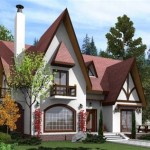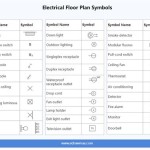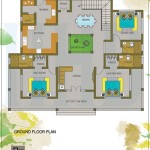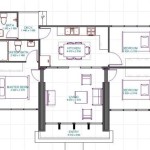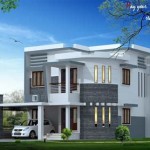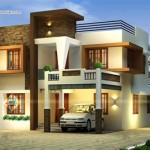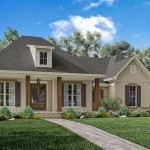One Floor Modern House Plans: A Comprehensive Overview
One-floor modern house plans are gaining significant traction in the contemporary residential architecture landscape. Characterized by their accessibility, open layouts, and integration of modern design principles, these plans cater to a diverse range of homeowners, from young families to retirees. The increasing popularity of single-story dwellings reflects a shift towards prioritizing convenience, sustainability, and adaptable living spaces.
Modern design, when combined with a single-level layout, often emphasizes clean lines, minimalist aesthetics, and the strategic use of natural light. This architectural style promotes a sense of spaciousness and flow, fostering an environment that is both functional and visually appealing. The elimination of stairs simplifies movement within the home, creating a more accessible environment for individuals with mobility challenges and enhancing the overall sense of connectivity between different living areas.
This article will explore the key considerations, benefits, and design elements associated with one-floor modern house plans, offering a comprehensive understanding of this evolving architectural trend. The aim is to provide prospective homeowners and design professionals with valuable insights into the possibilities and practicalities of single-story modern living.
Accessibility and Universal Design
One of the primary advantages of one-floor house plans is their inherent accessibility. The absence of stairs makes these homes ideal for individuals with mobility issues, families with young children, and those planning for aging in place. Universal design principles, which focus on creating spaces that are usable by people of all ages and abilities, are readily integrated into single-story layouts. This includes features such as wider doorways, roll-in showers, and strategically placed grab bars, ensuring that the home remains comfortable and functional throughout the homeowner's lifetime.
Beyond physical accessibility, single-story homes also offer improved sensory accessibility. The seamless connection between interior and exterior spaces allows for better natural ventilation and lighting, contributing to a more comfortable and stimulating environment. Reduced noise transmission between floors also enhances the overall tranquility of the home. These factors are particularly beneficial for individuals with sensory sensitivities or those seeking a more peaceful living environment.
The focus on accessibility in one-floor modern house plans aligns with the growing awareness of inclusive design practices. By eliminating physical barriers and incorporating user-friendly features, these homes promote independence and enhance the quality of life for residents of all abilities. The long-term benefits of investing in an accessible home far outweigh the initial costs, making it a wise choice for those seeking a sustainable and adaptable living solution.
Open Concept Living and Space Optimization
Modern architecture is often characterized by open-concept layouts, which are particularly well-suited to single-story homes. An open floor plan typically combines the living room, dining area, and kitchen into a single, expansive space, fostering a sense of connection and facilitating social interaction. This design approach also allows for greater flexibility in furniture arrangement and space utilization.
One-floor plans allow for maximizing horizontal space, enabling a more efficient flow between different zones within the home. Strategically positioned windows and skylights can further enhance the sense of spaciousness and bring natural light deep into the interior. Thoughtful consideration of circulation paths, furniture placement, and storage solutions is crucial for optimizing the functionality and comfort of the open layout.
The integration of outdoor living spaces, such as patios and decks, is another key element of modern single-story design. These transitional areas blur the boundaries between indoors and outdoors, extending the living space and providing opportunities for relaxation and entertainment. Large sliding glass doors and windows create a seamless connection between the interior and exterior, allowing for natural light and ventilation to flow freely throughout the home.
Modular construction and prefabrication techniques are increasingly used in the creation of one-floor modern homes. These methods offer significant advantages in terms of cost-effectiveness, construction speed, and quality control. Modular homes are built in a controlled factory environment, minimizing waste and ensuring precise construction standards. The modules are then transported to the building site and assembled on a prepared foundation, reducing the overall construction time and minimizing disruption to the surrounding environment.
Sustainable Design and Energy Efficiency
Sustainability is a central theme in modern architecture, and one-floor house plans offer numerous opportunities for incorporating eco-friendly design principles. The reduced building footprint compared to multi-story homes contributes to minimizing environmental impact. Furthermore, the simple layout facilitates the implementation of energy-efficient technologies and strategies.
Passive solar design, which involves orienting the home to maximize solar heat gain in the winter and minimize it in the summer, is particularly effective in single-story structures. Properly positioned windows and overhangs can significantly reduce the need for artificial heating and cooling, lowering energy consumption and reducing utility bills. High-performance insulation, energy-efficient windows and doors, and airtight construction are essential for minimizing heat loss and gain.
Renewable energy systems, such as solar photovoltaic (PV) panels and solar water heating systems, can be easily integrated into one-floor modern house plans. The ample roof space provides a suitable platform for installing solar panels, which can generate clean electricity and reduce reliance on fossil fuels. Rainwater harvesting systems, which collect and store rainwater for non-potable uses such as irrigation and toilet flushing, can further conserve water resources and reduce the home's environmental footprint.
The choice of building materials also plays a crucial role in the sustainability of a one-floor modern home. Using locally sourced, recycled, and renewable materials can minimize the environmental impact of construction. Selecting durable and low-maintenance materials reduces the need for frequent repairs and replacements, extending the lifespan of the home and minimizing waste over time. Examples of sustainable materials include bamboo, reclaimed wood, recycled concrete, and low-VOC paints and finishes.
Green building certifications, such as LEED (Leadership in Energy and Environmental Design) and Passive House, provide a framework for designing and constructing high-performance, sustainable homes. These certifications establish specific performance targets for energy efficiency, water conservation, indoor environmental quality, and material selection. Pursuing a green building certification demonstrates a commitment to sustainability and adds value to the home.
The integration of smart home technology can further enhance the energy efficiency and sustainability of one-floor modern house plans. Smart thermostats can automatically adjust the temperature based on occupancy and weather conditions, optimizing energy consumption. Smart lighting systems can dim or turn off lights when not in use, reducing electricity usage. Smart irrigation systems can monitor soil moisture levels and adjust watering schedules accordingly, conserving water. These technologies empower homeowners to manage their energy and water consumption more effectively, reducing their environmental impact and lowering utility costs.
Landscaping also plays a crucial role in the sustainability of a one-floor modern home. Native plants that are adapted to the local climate require less water and maintenance than non-native species. Drought-tolerant landscaping can further conserve water resources. Planting trees and shrubs can provide shade, reducing the need for air conditioning and improving the overall energy efficiency of the home. Permeable paving materials can allow rainwater to infiltrate into the ground, reducing stormwater runoff and replenishing groundwater supplies.
In conclusion, one-floor modern house plans offer a compelling combination of accessibility, open living, and sustainable design. By carefully considering the design elements and implementing energy-efficient technologies, homeowners can create a comfortable, functional, and environmentally responsible living space that meets their evolving needs.

Modern House Oz71 Floor Plans Southern One

Modern House Oz71 Narrow Plans Small

Contemporary House Plans Home Design Floor

Single Story Modern House Plans Floor Designs Houseplans Com

House Plan 1 Bedrooms 5 Bathrooms 3297 Drummond Plans

The Merivale One Y Display Home Ross North Homes Perth Modern House Design Plans Plan Gallery

4 Bedroom Modern Contemporary House Plan Plans

Plan 81203 Modern House 3 Bedrooms Great Window Views

10 Simple Floor Plans For House Builders Blog Eplans Com

Warm Modern House Plans Blog Dreamhomesource Com

